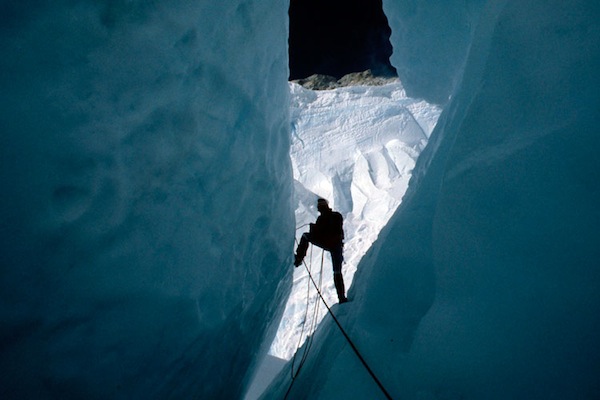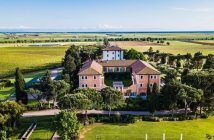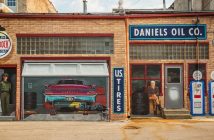The Messner Mountain Museum in Ortles is situated in the tiny alpine village of Solda, 1,900 metres above sea level. The land here is covered with snow for seven months of the year which is fitting, for the museum is devoted to the world of ice. ‘At MMM Ortles,’ proclaims the programme, ‘Reinhold Messner tells of the Terrors of Ice and Darkness, Snow People and Snow Lions, the Whiteout and the Third Pole.’ The MMM Ortles was the only Messner museum of the five built from scratch. Rather than perched in a lofty tower, here he decided to dig down, burrowing into the foot of the mountain itself to create a sort of submerged concrete bunker.
Words are powerful conveyors of experience. I had read much and was hearing more about Messner’s exploits. What gave a further dimension to these, even more so than the collection of ice climbing gear stretching back two hundred years, were the paintings that hung in profusion on the white walls. For as much as it was a museum, the MMM Ortles was a gallery, and a good one. The paintings varied in size, medium and execution from vast canvases slathered in impasto oil to tiny scraps of paper scratched in pen and ink. There was a good historical representation too from the time Romanticism led the charge into the mountains to contemporary contemplations of sheer ice walls. There were no Caspar David Friedrich’s on display (“Too expensive,” Messner later told me, “and besides, he is well-shown in the great museums”) but there were plenty of paintings that came close in skill and atmosphere.
Amongst these were some by Julius Payer, a nineteenth century Austro-Hungarian gentleman, soldier, explorer and painter who produced some startlingly bold works in the Romantic tradition. In fact, many of the painters were alpinists themselves and I believe it was this knowledge and respect of the mountains that helped to give the paintings their power. Often tiny figures could be seen labouring across vast landscapes. In them was conveyed the sense of the loneliness of the mountains, the inconsequentiality of man in the face of the might and indifference of nature. “Flee, my friend, into thy solitude – and thither, where a rough strong breeze bloweth,” ran a quote by Friedrich Nietzsche. Some of the best were the little watercolours where you had to squint to see the detail. The soft evanescent colours perfectly captured the passing of light and the seasons – and of man – against the Methuselah solidity of the mountains themselves.
After this we took a ski lift up the Ortler itself, known in the region as Konig (King) Ortler and at 3,905 metres, the highest mountain in the Eastern Alps. The air was fresh and despite being June, it was still pretty cold. Snow still lay in hollows and in the shadows of boulders. We milled about on a broad terrace below a ski café. Cameras clicked as Messner pointed out the various climbing routes he had taken as a young man. This was his back yard and whilst ordinary boys would be climbing trees, he was scaling the peaks surrounding us. It seemed he knew every inch of them. It was strange – we were up there, as close as we were possibly going to get to the environment in which he made his name, but still it was difficult to picture. With the big unwieldy group, the pristine walking boots, anoraks and ski lift, it all just felt so… comfortable. “The climbers of today, they need this, how you call it… this knowledge from outside because they are training in the indoor climbing halls and there is no danger. Indoor is not outdoor.” Messner comments.
It is not the only thing that has changed since his day. The great Ortler glacier has been retreating steadily for years. He pointed to the old summer reach of the glacier. The gap between then and now is shocking. The mountains, vast and seemingly indestructible, are clearly not invulnerable. The effects of climate change are plain to see. It was the ticket for which he campaigned as Green MEP between 1999 and 2004.
After this we were let off the leash and allowed to wander back down the mountainside along a rock strewn path. Above the tree-line the high tundra was flecked with the most delicate flowers – small, but in that climate, incredibly strong. The group began to string out as some dawdled in knots or laboured slowly in the thin air and others, fitter and more agile, stepped lightly down the hillside. Soon I was alone and in that solitude began to experience something of the character and majesty of the mountain. I descended through the tree-line and was suddenly surrounded by great grey-trunked pines, their boles fringed with shaggy lichens. My nostrils were filled with the wonderful scent of pine sap and apart from the occasional voice that echoed back from the rocks, I could neither hear nor see anyone.
“Obstacles energise me!” Messner has said with provocative relish. The tragedy and injuries which occurred on the 1970 Nanga Parbat expedition did not finish him. On the contrary, in many ways they could be seen as leading directly to his later triumphs. “High altitude was not interesting to me, it was not steep enough – it was hiking, and I would never want to hike a mountain.” But Messner couldn’t rock climb now, at least to the level he had experienced, “And so I became a high altitude climber.”
But this wasn’t all. In 1967, at the age of twenty three, he penned the seminal essay, ‘The Murder of the Impossible’. In it he described the siege tactics of the old unwieldy expeditions, laying claim to a mountain bolt by bolt. He speaks on behalf of the mountain that cannot “defend itself” and against the defilers who “carries courage in his rucksack.” It was a clarion call, skewering those that believed safety should come first and exciting the young Turks and risk takers who were seeking something more. It was typically devisive but saw Messner spearheading the new ‘alpine style’ of climbing which relied on speed and lightness and not on equipment. It was written before he was famous, whilst still a rock climber, but it was the same spirit and philosophy that he took with him when tackling the ‘Eight Thousanders’. It was the same basic idea that led him to rejecting the need for bottled oxygen and declaring, before starting for Everest, “I will achieve it by fair means or not at all.”
For the fifteen years after the 1970 Nanga Parbat expedition, Messner threw himself into the business of high altitude climbing with superhuman energy and conviction. In it there was almost a sense of time running out, the climber’s acute awareness of the teetering transience of life. “If you are really in difficult places, in dangerous places… and you come back, you feel that you got again a chance for life. You are reborn. And only in this moment, you understand deeply that life is the biggest gift we have.” One by one the dragons Messner talked about in his essay fell to his sword. In 1975, together with long-term climbing partner Peter Habeler, he conquered the eight thousand metre summit of Gasherbrum 1, one of the fierce titans of the Himalayas. And true to his pledge, he did it in true Alpine style – no fixed ropes, camps or oxygen. Three years later, in 1978, working in the same partnership, Messner returned with a single defining goal – to climb Everest without oxygen.




